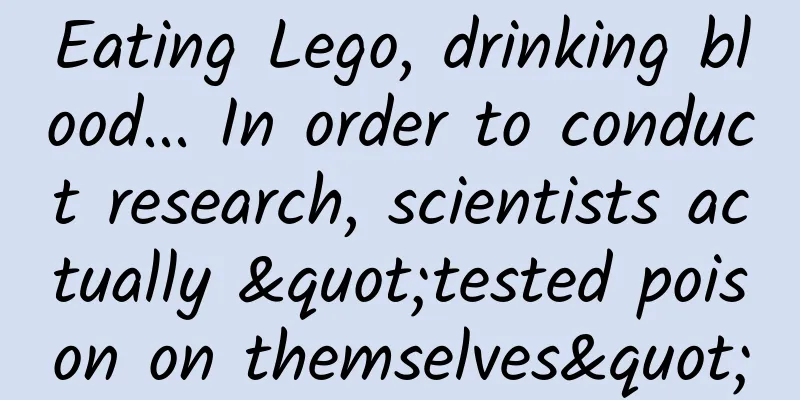Eating Lego, drinking blood... In order to conduct research, scientists actually "tested poison on themselves"

|
Which of the following foods is the most difficult for you to swallow? Option A: Houttuynia cordata B: Pig brain flower C: Hairy tofu D: Fried insects Although some people cannot accept these options, they are still considered food. However, when researchers do research, what they eat is not limited to food. Lego blocks, their own blood, Helicobacter pylori... For the sake of research, they really "test poison on themselves", and some have even won the Nobel Prize for this. Why did scientists do this to themselves? Is it the decline of morality or the distortion of human nature? (Neither) Eating Lego a day Digging shit for days If you accidentally swallowed a toy, should you go to the hospital immediately to have your stomach opened, or wait two days and then encounter it again when you go to the toilet? For adults, this may be a rare event, but for parents with babies, children swallowing toys by mistake has always been a dangerous accident. In order to explore this issue, researchers focused on Lego, which is made up of small parts. Researchers eat Lego figurines' head parts. Don't imitate! | Damian Roland/Youtube A research team launched a recruitment. After excluding those with a history of gastrointestinal surgery, those who could not ingest foreign objects, and those who did not want to search for toys in their feces, six pediatric health professionals participated in the experiment. What they had to do was to eat the head component of the Lego toy man and search their feces for it after each bowel movement. See you in the shit :) | References [2] Finally, five participants found the piece of Lego in their feces, and they met the cute head component again in the 1st to 3rd bowel movements after swallowing Lego, and there were no complications during this period. However, one participant did not see the Lego again for two weeks. The study was limited in sample size and experimental methods, and it can't explain how other types of toys behave in the intestines. But at least for the Lego head, the researchers believe that in most cases, such foreign objects can be excreted with feces. Of course, if anyone accidentally swallows a foreign object in life and experiences any discomfort, they must seek medical attention! By the way, the researchers also reminded parents: It is best not to look for foreign objects in the feces yourself, because it is really difficult to find. Researcher: "Look again and I'll eat you" (No) | Pixabay "Vampire Experiment" Drink your own blood In the summer of 2018, on a dark and windy night, an article on "vampire research" appeared in the Joint European Journal of Gastroenterology. The experimental material used by the researchers was not pig blood or duck blood, but human blood. If swallowing toys may cause physical discomfort, then drinking your own blood is a bit of a mental pollution... Is this drinkable? | Giphy In this study, 16 participants collected their own blood through intravenous sampling and ingested it directly by drinking or through a nasogastric tube. This experiment sounds incredible, but it is full of significance: drinking blood is to simulate gastrointestinal bleeding. The researchers analyzed the participants' stool indicators to verify whether gastrointestinal bleeding would interfere with this indicator of inflammatory bowel disease. The researchers found that all participants tolerated the blood ingestion. Eight participants experienced mild side effects, such as nausea, bloating, or heartburn, which lasted less than 24 hours. Constipation occurred in six and five participants after ingesting 100 mL and 300 mL of blood, respectively. Four participants experienced diarrhea after ingesting 100 mL and 300 mL of blood, respectively. Of course, this study was approved by the local ethics committee, and the participants were strictly screened and physically examined. So please don't try this yourself. If you are thirsty, drink water. If you are hungry, go to the hot pot restaurant and order some duck blood! Do you eat mushrooms? Helicobacter pylori The pinnacle of eating strange things to do research is probably like Barry Marshall, who won the Nobel Prize by drinking a glass of Helicobacter pylori. In 1984, Australian scientist Marshall scraped freshly grown Helicobacter pylori from other culture dishes, mixed it in a broth-like culture medium, about 20 mL, and drank it all in one gulp. Marshall: The culture medium has a very strong taste. Although I don’t like it, I still drank it all|Giphy Prior to this, he had an endoscopy to make sure he was not infected with Helicobacter pylori. Three days after drinking the broth, he began to feel nauseous and vomited, and even his mother thought he had bad breath. In a subsequent examination, he found that his stomach was inflamed. Fourteen days later, he began taking antibiotics for treatment at the request of his wife. Marshall thus demonstrated a link between Helicobacter pylori and gastritis, shocking other scientists. At that time, the mainstream medical concept was that no bacteria could survive in the highly acidic environment of the gastric mucosa, and that diseases such as gastric ulcers were caused by excessive stress, which increased gastric acid secretion. Marshall and his team found a bacterium and proposed a hypothesis that this bacterium could cause gastric mucosal damage, leading to gastritis, gastric ulcers and even gastric cancer. This hypothesis was ridiculed by prominent scientists, and although Marshall had successfully used antibiotics to treat patients with gastric ulcers at the time, he was unable to convince other doctors to use this approach without reliable experimental data. Marshall tried to prove his hypothesis and spent six months infecting piglets with Helicobacter pylori, but the experiment failed. Marshall had no choice but to try autologous experiments - infecting himself with Helicobacter pylori. He drank the broth secretly without discussing it with his boss, fearing that he would be forbidden to do such experiments. When publishing the paper, Marshall also said that the person who underwent the experiment was a "male volunteer". Later people found out that the "male volunteer" in the article was Marshall himself. The attack of Helicobacter pylori, more than 50% of Chinese people are infected| care.care.com Until now, there has been more and more evidence proving the role of Helicobacter pylori in gastritis, gastric ulcer and other stomach diseases. These diseases are no longer unpredictable "mysterious killers". Self-experimentation is history If you want to conduct experiments on animals or human volunteers, you need to go through layers of ethical review. In order to prove their research conclusions, scientists sometimes devote themselves to science by conducting self-experiments. A study of self-experimentation over the past two centuries found that the peak of self-experimentation occurred in the first half of the 20th century. Scientists face great dangers, but they may also receive honors, even Nobel Prizes. In addition to Marshall, the last scientist who won the Nobel Prize for self-experimentation was Werner Forssmann, who invented the cardiac catheter. Because he could not get permission to perform such a dangerous operation, he performed experiments on himself. He inserted a 65cm long catheter into the vein in front of his elbow and inserted it into the right atrium, then ran to take an X-ray to record the operation. In 1956, he won the Nobel Prize in Physiology or Medicine. X-ray images of Forsman's self-experimentation when he was only 24 years old|Nobel Prize/Facebook The worst outcome of self-experimentation was personal death. Some scientists died from immune reactions to multiple blood transfusions, while others infected themselves with yellow fever—and although they eventually recovered, they continued to suffer from poor health and died early. However, fewer and fewer people are doing autologous experiments now. One reason may be that we have entered the era of molecular biology, and the research methods are becoming more and more complex and sophisticated, making autologous experiments less and less necessary. These scientists and volunteers who conduct experiments on themselves have promoted the advancement of medicine and will always be heroes. References [1] Hampton, R., J. Wong, and M. Singh. "Lego of that." British dental journal 212.3 (2012): 105-105. [2] Tagg, Andrew, et al. "Everything is awesome: Don't forget the Lego." Journal of pediatrics and child health 55.8 (2019): 921-923. [3] If You Swallow A Lego, Here Is When You'll Get It Back. https://www.forbes.com/sites/brucelee/2018/11/24/if-you-swallow-a-lego-here-is-when-youll-get-it-back/?sh=23c6c52f5d01 [4] Vavricka, Stephan R., et al. "The Vampire Study: Significant elevation of faecal calprotectin in healthy volunteers after 300 ml blood ingestion mimicking upper gastrointestinal bleeding." United European gastroenterology journal 6.7 (2018): 1007-1014. [5] These People Drank Their Own Blood — for Science! https://www.livescience.com/63671-vampire-study-blood-ibd.html [6] Barry Marshall Biographical. https://www.nobelprize.org/prizes/medicine/2005/marshall/facts/ [7] Helicobacter pylori: A Nobel pursuit? https://www.ncbi.nlm.nih.gov/pmc/articles/PMC2661189/ [8] When Scientists Experiment on Themselves: H. pylori and Ulcers. https://blogs.scientificamerican.com/guest-blog/when-scientists-experiment-on-themselves-h-pylori-and-ulcers/ [9] Q&A: Barry Marshall. https://www.nature.com/articles/514S6a [10] Self-Experimentation and Its Role in Medical Research. https://www.ncbi.nlm.nih.gov/pmc/articles/PMC3298919/ [11] The Doctor Who Drank Infectious Broth, Gave Himself an Ulcer, and Solved a Medical Mystery. https://www.discovermagazine.com/health/the-doctor-who-drank-infectious-broth-gave-himself-an-ulcer-and-solved-a-medical-mystery [12] Werner Forssmann Biographical. https://www.nobelprize.org/prizes/medicine/1956/forssmann/biographical/ [13] Marshall, BJ, Armstrong, JA, McGechie, DB, & Clancy, RJ (1985). Attempt to fulfill Koch's postulates for pyloric Campylobacter. Medical Journal of Australia, 142(8), 436-439. *Photo of the Lego figurine in the title picture: @IJM93/Twitter Author: Towel, Owl Editor: Window Knocking Rain, Owl An AI What, you ask where the missing Lego head went? The researcher said in an interview: "Who knows? Maybe one day, many years later, when a gastroenterologist performs a colonoscopy on this participant, he will find the Lego man staring at him : )" This article comes from Guokr and may not be reproduced without permission. If necessary, please contact [email protected] |
Recommend
Doing 600 high jumps every day causes bone inflammation...Can I still jump after doing this?
Previously, some parents gave their children sex ...
Psyduck is not a duck!
Recently, KFC and Pokémon jointly launched a seri...
How can operations move from the extensive stage to the refined stage?
Last week I went to Didi and was invited to talk a...
A must-read for entrepreneurs: How long does it take to develop an App?
[[219589]] With an estimated 350 billion mobile a...
"Xiaobai Moving Brick Project 1.0" is operated purely on mobile phone, and you can earn some pocket money by working part-time every day
Course Contents: 1. Project Introduction.mp4 2. P...
How does information flow advertising accurately target users?
In this article, we will learn about people with ...
How should Tik Tok create a hit? Official TikTok hit tips!
The rise of short videos has brought countless ne...
Xiaohongshu Hot Note Titles (Tutorial Included)
There are too few eyes in the notes and the numbe...
When people get old, do they really smell like old people?
People with life experience know that many elderl...
How to withdraw provident fund after resigning? Conditions for withdrawing housing provident fund after resignation in Zhengzhou
How to withdraw provident fund after resigning? A...
Why does Italy, which has been calling for imposing tariffs on Chinese electric vehicles, now want its beautiful prime minister to come and ask for investment?
Should tariffs be imposed on Chinese electric veh...
Pinduoduo’s marketing gamification!
Pinduoduo’s ability to carve out a path in the fi...
Testing the audit loophole of BOSS Zhipin: Fake recruitments are over in 3 minutes and resumes are pouring in
From Wei Zexi to job seeker Li Wenxing, the produ...
Will you have a spending spree after the Wuhan pneumonia epidemic? Which industries are likely to experience a consumption frenzy?
A sudden epidemic has forced most people to stay ...









